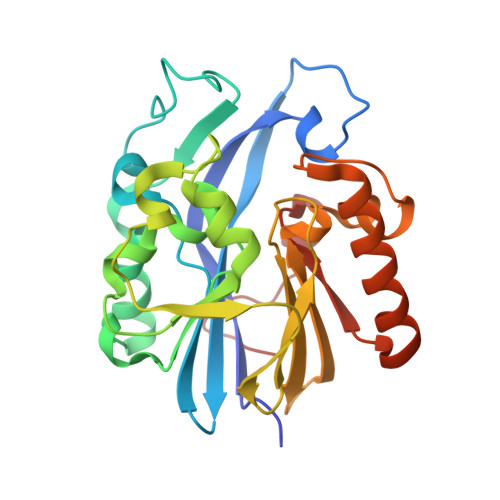A phenylalanine clamp controls substrate specificity in the quorum-quenching metallo-gamma-lactonase from Bacillus thuringiensis.
Liu, C.F., Liu, D., Momb, J., Thomas, P.W., Lajoie, A., Petsko, G.A., Fast, W., Ringe, D.(2013) Biochemistry 52: 1603-1610
- PubMed: 23387521
- DOI: https://doi.org/10.1021/bi400050j
- Primary Citation of Related Structures:
4J5F, 4J5H - PubMed Abstract:
Autoinducer inactivator A (AiiA) is a metal-dependent N-acyl homoserine lactone hydrolase that displays broad substrate specificity but shows a preference for substrates with long N-acyl substitutions. Previously, crystal structures of AiiA in complex with the ring-opened product N-hexanoyl-l-homoserine revealed binding interactions near the metal center but did not identify a binding pocket for the N-acyl chains of longer substrates. Here we report the crystal structure of an AiiA mutant, F107W, determined in the presence and absence of N-decanoyl-l-homoserine. F107 is located in a hydrophobic cavity adjacent to the previously identified ligand binding pocket, and the F107W mutation results in the formation of an unexpected interaction with the ring-opened product. Notably, the structure reveals a previously unidentified hydrophobic binding pocket for the substrate's N-acyl chain. Two aromatic residues, F64 and F68, form a hydrophobic clamp, centered around the seventh carbon in the product-bound structure's decanoyl chain, making an interaction that would also be available for longer substrates, but not for shorter substrates. Steady-state kinetics using substrates of various lengths with AiiA bearing mutations at the hydrophobic clamp, including insertion of a redox-sensitive cysteine pair, confirms the importance of this hydrophobic feature for substrate preference. Identifying the specificity determinants of AiiA will aid the development of more selective quorum-quenching enzymes as tools and as potential therapeutics.
Organizational Affiliation:
Department of Chemistry and Rosenstiel Basic Medical Sciences Research Center, Brandeis University, Waltham, Massachusetts 02454, USA.
















